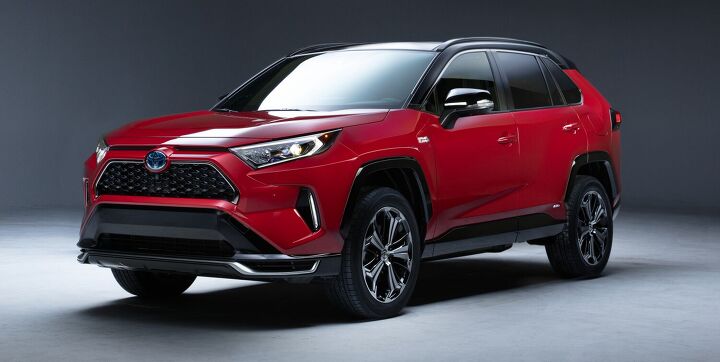Toyota RAV4 Hybrid Fails the Moose Test in Dramatic Fashion

Sweden’s evasive maneuver test, better known as the moose test, is a brutal simulation of what might happen if your lane was suddenly occupied by a giant mammal and you had to get out of the way in a hurry or prepare yourself to become one with the animal. It also happens to be one of the hardest automotive tests to pass, with a long list of models failing to stay on course at highway speeds. In fact, the whole point of the test is to see how fast a vehicle can run the brief gauntlet without running over traffic cones or flipping itself over.
As a result, the cars that typically perform the best tend to be lightweight road huggers with above-average factory rubber. Meanwhile, crossovers and pickups have had particularly poor showings — with Toyota’s RAV4 embarrassing itself rather badly in 2019 after Stockholm’s Teknikens Värld (one of the European publications that made the test world-famous) showed its stability management system was ill-equipped to handle the course. While Toyota went out of its way to remedy the issue with a software update in Europe, recent testing showed the RAV4 PHEV was back to its old tricks… or lack thereof.
Things were so terrible that testers reportedly double-checked to see if the vehicle’s electronic stability control (ESC) was even active. Realizing that it was, the outlet called the results “scandalously bad” and added that the car would probably perform worse loaded with passengers. COVID restrictions required the test to swap in sandbags to adhere to testing protocols, lowering its center of mass a bit.
But it wasn’t the only mainstream crossover that failed and that’s not terribly surprising if you’ve spent any time driving them hard. The Mitsubishi Outlander and Volvo XC40 Recharge T4 being tested at the same time as the Toyota also failed — albeit less dramatically. Teknikens Värld suggested this was one of the pitfalls of the segment, though made it clear that there are a few crossovers capable of handling the moose test with enough grace to warrant a recommendation.
[Image: Toyota]

A staunch consumer advocate tracking industry trends and regulation. Before joining TTAC, Matt spent a decade working for marketing and research firms based in NYC. Clients included several of the world’s largest automakers, global tire brands, and aftermarket part suppliers. Dissatisfied with the corporate world and resentful of having to wear suits everyday, he pivoted to writing about cars. Since then, that man has become an ardent supporter of the right-to-repair movement, been interviewed on the auto industry by national radio broadcasts, driven more rental cars than anyone ever should, participated in amateur rallying events, and received the requisite minimum training as sanctioned by the SCCA. Handy with a wrench, Matt grew up surrounded by Detroit auto workers and managed to get a pizza delivery job before he was legally eligible. He later found himself driving box trucks through Manhattan, guaranteeing future sympathy for actual truckers. He continues to conduct research pertaining to the automotive sector as an independent contractor and has since moved back to his native Michigan, closer to where the cars are born. A contrarian, Matt claims to prefer understeer — stating that front and all-wheel drive vehicles cater best to his driving style.
More by Matt Posky
Latest Car Reviews
Read moreLatest Product Reviews
Read moreRecent Comments
- W Conrad I'd gladly get an EV, but I can't even afford anything close to a new car right now. No doubt if EV's get more affordable more people will be buying them. It is a shame so many are stuck in their old ways with ICE vehicles. I realize EV's still have some use cases that don't work, but for many people they would work just fine with a slightly altered mindset.
- Master Baiter There are plenty of affordable EVs--in China where they make all the batteries. Tesla is the only auto maker with a reasonably coherent strategy involving manufacturing their own cells in the United States. Tesla's problem now is I think they've run out of customers willing to put up with their goofy ergonomics to have a nice drive train.
- Cprescott Doesn't any better in red than it did in white. Looks like an even uglier Honduh Civic 2 door with a hideous front end (and that is saying something about a Honduh).
- Kwik_Shift_Pro4X Nice look, but too short.
- EBFlex Considering Ford assured us the fake lightning was profitable at under $40k, I’d imagine these new EVs will start at $20k.


































Comments
Join the conversation
I wonder if a “normal” non-bling set of tires would help this test? Low-profile rubber bands on over-size wheels don’t work very well when the vehicle starts to roll into a sharp turn.
The recommendation regarding deer is to brake but maintain a straight line. Swerving to avoid is not recommended because you are just as likely to swerve into the path of the deer, hence brake and maintain a straight line. Furthermore, a sudden swerve will just as likely cause a loss of control without providing any increase in deer avoidance. Here in Minnesota where I live, deer are not known to stand on an open road. When they enter the road they move quite quickly. As others have noted, often times by the time you see the deer it is too late anyway. Also note that deer are extremely gifted leapers. I once had a deer appear out of nowhere from the passenger side of the car. It leapt across the road, taking it over the hood of our SUV (a Mazda Tribute) and clipping the upper A pillar on the driver's side with its rear hoof. A moose will not leap the way a deer can leap.